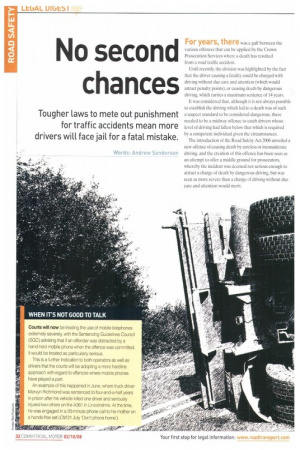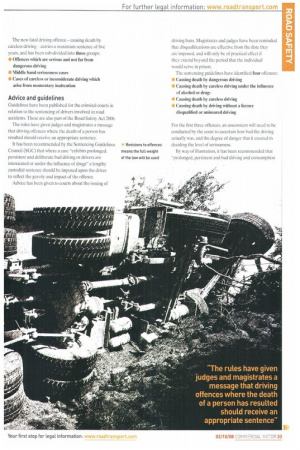No second chances
Page 32

Page 33

Page 34

If you've noticed an error in this article please click here to report it so we can fix it.
Tougher laws to mete out punishment for traffic accidents mean more drivers will face jail for a fatal. mistake.
Words: Andrew Sanderson For years, there was a gulf between the various offences that can be applied by the Crown Prosecution Services where a death has resulted from a road traffic accident.
Until recently, the division was highlighted by the fact that the driver causing a fatality could be charged with driving without due care and attention (which would attract penalty points), or causing death by dangerous driving, which carries a maximum sentence of 14 years.
It was considered that, although it is not always possible to establish the driving which led to a death was of such a suspect standard to be considered dangerous, there needed to be a midway offence to catch drivers whose level of driving had fallen below that which is required by a competent individual given the circumstances.
The introduction of the Road Safety Act 2006 unveiled a new offence of causing death by careless or inconsiderate driving, and the creation of this offence has been seen as an attempt to offer a middle ground for prosecutors, whereby the incident was deemed not serious enough to attract a charge of death by dangerous driving, but was seen as more severe than a charge of driving without due care and attention would merit. The new fatal driving offence — causing death by careless driving carries a maximum sentence of five years, and has been sub-divided into three groups: • Offences which are serious and not far from dangerous driving • Middle hand seriousness cases • Cases of careless or inconsiderate driving which arise from momentary inattention
Advice and guidelines
Guidelines have been published for the criminal courts in relation to the sentencing of drivers involved in road accidents. These are also part of the Road Safety Act 2006.
The rules have given judges and magistrates a message that driving offences where the death of a person has resulted should receive an appropriate sentence.
It has been recommended by the Sentencing Guidelines Council (SGC) that where a case "exhibits prolonged. persistent and deliberate bad driving or drivers are intoxicated or under the influence of drugs" a lengthy custodial sentence should be imposed upon the driver to reflect the gravity and impact of the offence.
Advice has been given to courts about the issuing of driving bans. Magistrates and judges have been reminded that disqualifications are effective from thedate they are imposed, and will only be of practical effect if they extend beyond the period that the individual would serve in prison.
The sentencing guidelines have identified four offences: • Causing death by dangerous driving • Causing death by careless driving under the influence of alcohol or drugs • Causing death by careless driving • Causing death by driving without a licence disqualified or uninsured driving For the first three offences, an assessment will need to be conducted by the court to ascertain how had the driving actually was, and the degree of danger that it created in deciding the level of seriousness.
By way of illustration, it haS been recommended that "prolonged, persistent and had driving and consumption
of substantial amounts of drugs or alcohol" would mean offenders would be placed in the most serious category of causing death by dangerous driving and should expect to receive a sentence of at least seven years.
However, it should also be noted that if the causing death by dangerous driving offence is accompanied by further aggravating features, including failing to stop after the incident, then the sentence should be increased towards the maximum of 14 years.
A middle ground
Courts have also been given guidance in relation to dealing with cases of causing death by careless driving under the influence of alcohol or drugs.
The advice states that longer sentences should be imposed based on the degree of intoxication effectively introducing a 'slide-rule' effect.
Where death follows careless driving, a custodial sentence of up to three years should be expected. with an increased sentence where aggravating factors are present.
The introduction of the death by careless driving offence has provided a middle ground whereby the Crown Prosecution Service can now prosecute people for more serious offences than driving without due care and attention, but also avoid the difficulty of attempting to prove the higher offence of death by dangerous driving.
It is vital that professional drivers and operators are aware of the new offences and sentencing reforms to ensure that their standards of driving remain high. • • Andrew Sanderson is a Solicitor Advocate and Associate with Weightmans LLP, specialising in road transport regulatory law.
Contact: andrew.sandersonOweightmans.com




































































































































































